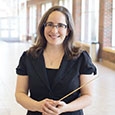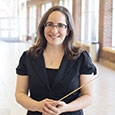Ensemble directors draw on experiences with countless conductors to develop their teaching methods. They borrow techniques that they connect with and also develop their own crazy ideas on the spot. Here are some techniques that help keep rehearsals fresh for me.
Foster the Family
I strive to make band an environment where students can create beauty, develop life-long friends, challenge and support each other, and have a bright spot in their day. If I am resolving a problem or we are between pieces, I will ask students to share a bit of information with their neighbors: favorite colors, places they want to visit, vacations, desserts, and music. You can also have them move around the room if you don’t think that will lead to chaos. These small moments have contributed to great success in building relationships, a big reason students stick with any ensemble.
Food
One day I asked my students to close their eyes and picture a big plate of their favorite food sitting in front of them. I encouraged them to observe the textures and smells. The results were amazing with smiles across the whole room and some satisfied noises. This also activated their salivary glands, and the band played incredibly well after this. Beyond the physical effects, it created a calm and happy moment. Students are busy and stressed. They are inundated with information from teachers, technology, and the world around them. This was a moment of bliss and calm, and it focused them immediately.
A Healthy Mind and Body= A Healthy Musician and Student
I am a strong proponent of a healthy mindset. Students race around all day, and sometimes just need to pause. I use rehearsal time for meditation, stretching, Pilates, and yoga. I am not professionally trained in any of those areas but have participated in enough videos and classes to know what feels good for a musician. I encourage all teachers to investigate videos on YouTube or meditation apps.
I rely on intuition and empathy to judge when players need a break. Often I plan these out ahead of time, but if I sense the group is down or stressed out, I spend 5-10 minutes on meditation and stretching. A shorter, more focused rehearsal is far more productive than a full-length, inattentive class. I was encouraged to continue these sessions a few years ago when a student told me after rehearsal, “That was the best I have ever played.” She had needed the time to rest her mind and refocus herself.
Dalcroze and Breathing Gym
There are many great Dalcroze activities that train band students to embody beat, subdivision, and meter. I have found great success using Dalcroze with my marching band, concert bands, and conducting classes. Any kind of musical activity is worth the time, and students enjoy playing these games.
Band Bonding
I try to schedule several social activities for my band students every year. Attendance is optional, but game show nights, bowling, and picnics are generally successful. I find that when students socialize more, they support each other more and play better as a unit.
Band Yoga
I was working on a piece where the melody changed to different instruments every four measures and had a thick texture behind it. I prepared my score and dreaded the tedious rehearsals that would be required to explain who had the melody at each place in the music. I threw my hands up and decided to make my students figure it out. If directors always tell students who has the melody, they will never learn to listen actively. Before you do this, make sure that every student knows what the melody is. You can input it into a notation software and display it on a screen for everyone to play.
There are great opportunities for musicianship training here, too. Once everyone is back on their own parts, ask them to listen for that melody and identify it while playing. Ask them to analyze how they can enhance the melody. This takes some training but produces considerable long-term benefits.
I call this band yoga because it is similar to how yoga encourages complete body awareness. For example, as you do a yoga pose, a good instructor will ask you to feel each fingertip or toe pushing into the earth. Band Yoga encourages students to practice being aware of the entire ensemble, not just themselves.
(1).jpg)
Fun group social activities like bowling build a sense of ensemble that translates into better performance.
The ideas on the following page are some of the more tried and true techniques found in books, but I have suceeded with all of them.
Sit Wherever You Want
Ask students to take their music and instruments and sit somewhere else. You could also instruct them to do so as they enter the room to skip a step. I ask that they try not to sit next to anyone else in their section. I encourage the percussion to move, too, though the students playing the larger instruments usually stay where they are. You can often see students’ personalities and the instrument stereotypes many resemble with this exercise. I usually get at least one trumpet, trombone, and tuba in the front row. I use this technique only after students have a good grasp on notes, rhythms, and musicianship in a piece. It works particularly well for faster or technique-heavy music.
This technique creates improved awareness of themselves and each other. They are forced to be independent because they cannot rely on hearing others in their section. My favorite part is that they inevitably hear near new things, as do I. Changing the set-up makes everything fresh and exciting. My students love sitting somewhere new. Sometimes, I plan for this and sometimes I do it in the moment. If we are struggling with keeping time or energy this is a great exercise. I find they play with more energy, like when we sightread, and their focus is much improved.
Sit in a Circle
The design of the rehearsal room may prevent trying this, but it can be done on risers with a large enough room. This also requires time and muscle as the percussion will preferably go in the middle of the circle, and chairs and stands should be arranged before the students enter. You also could recruit students to do the moving as they enter the room. Having the percussionists in the middle helps them feel how essential they are. If they understand better how they fit in with the winds, this awareness may continue after returning to a normal set up. As far as the seating goes, you could seat by sections or mix them up.
Much like the first set-up, everyone (especially percussionists) will gain a fresh perspective. I like to do this with a percussion-heavy piece or music where the percussion really drive the energy. They are in the middle of it all, and both groups can feed off each other.
Flip the Band
Have the front rows flip their chairs around and face the back. As with the circle set-up, built-in risers may be an issue, but I have made this work by curving the front one or two rows out in a bow so there is a gap between the two groups. This works particularly well with jazz band. The sax section will turn around, and I have found the brass really benefit from hearing the saxes better. I love doing this when I have a great sax player or section, as the brass players will feed off their style.
No Conductor
This forces everyone to listen, including you. I often do this with one of the unusual rehearsal set-ups. I count students off and let them go. I stand or walk around so I can really listen to what is happening instead of just hearing what I expect when I look at a score. Students often gravitate to their leaders so this becomes a great exercise in non-verbal communication, and that pushes them to listen beyond themselves. Directors often encourage students to subdivide without explaining what that means. Letting them play on their own is a natural way to encourage those thoughts.
Stand and Play
This is a great solution when a group struggles to feel a steady beat. I often have students mark time so they embody the beat. Not everyone will mark time correctly, but with more training and practice, this could be a great exercise for students.
Musical Techniques
An important responsibility is to teach students how to practice. I encourage one or two elements at a time, such as rhythm. Mnemonics are wonderful for any age: my students from years ago still remember a funny-looking rhythm in cut time as: “I do like my blueberry, blueberry pie!” Together, we identify the peaks of phrases. Perhaps the brass players have some large leaps so we might play the notes as a chorale to get comfortable with each note. This also helps me identify wrong notes. Frequently, a third trumpet player will be on the wrong shelf, and this slow and steady approach helps me identify errors buried in a full band
texture.
By changing the normal routine, directors can tailor rehearsals to students’ needs. In addition, these memorable techniques and their excellent, sometimes surprising outcomes, help keep students interested in playing.






